Sediment Budget Implications from Posidonia oceanica Banquette Removal in a Starved Beach System
Abstract
:1. Introduction
2. Materials and Methods
2.1. Study Area
2.2. Beach and Banquette Surveys
2.3. Banquette Composition Characterisation
2.4. Carbonate Content on Core Sediments
3. Sediment Budget Calculation
4. Results
4.1. Carbonate Content on Cores
4.2. Sediment Budget
5. Discussion
Supplementary Materials
Author Contributions
Funding
Informed Consent Statement
Data Availability Statement
Acknowledgments
Conflicts of Interest
References
- Vassallo, P.; Paoli, C.; Rovere, A.; Montefalcone, M.; Morri, C.; Bianchi, C.N. The Value of the Seagrass Posidonia oceanica: A Natural Capital Assessment. Mar. Pollut. Bull. 2013, 75, 157–167. [Google Scholar] [CrossRef] [PubMed]
- Borum, J.; Duarte, C.M.; Krause-Jensen, D.; Greve, T.M. European Seagrasses: An Introduction to Monitoring and Management; The M&MS Project: Copenhagen, Denmark, 2004; ISBN 87-89143-21-3. [Google Scholar]
- De Falco, G.; Simeone, S.; Baroli, M. Management of Beach-Cast Posidonia oceanica Seagrass on the Island of Sardinia (Italy, Western Mediterranean). J. Coast. Res. 2008, 4, 69–75. [Google Scholar] [CrossRef]
- Simeone, S.; De Muro, S.; De Falco, G. Seagrass Berm Deposition on a Mediterranean Embayed Beach. Estuar. Coast. Shelf Sci. 2013, 135, 171–181. [Google Scholar] [CrossRef]
- Roig-Munar, F.X.; Rodríguez-Perea, A.; Martín-Prieto, J.Á.; Bernardi, G.F. Quantification of sediment loss due to the mechanical removal of berms (banquettes) of Posidonia oceanica on the beaches of the Balearic Islands: Geomorphological consequence. Rev. De La Soc. Geológica De España 2019, 32, 14. [Google Scholar]
- Otero, M.; Simeone, S.; Aljinovic, B.; Salomidi, M.; Mossone, P.; Giunta Fornasin, M.E.; Gerakaris, V.; Guala, I.; Milano, P.; Heuertefeux, H.; et al. Governance and Management of Posidonia Beach-Dune System; IUCN Centre for Mediterranean Cooperation: Málaga, Spain, 2018; p. 66. [Google Scholar]
- Pasqualini, V.; Pergent-Martini, C.; Clabaut, P.; Pergent, G. Mapping Of Posidonia oceanica using Aerial Photographs and Side Scan Sonar: Application off the Island of Corsica (France). Estuar. Coast. Shelf Sci. 1998, 47, 359–367. [Google Scholar] [CrossRef]
- Duarte, C.M. Seagrass Depth Limits. Aquat. Bot. 1991, 40, 363–377. [Google Scholar] [CrossRef]
- Boudouresque, C.F.; Ponel, P.; Astruch, P.; Barcelo, A.; Blanfuné, A.; Geoffroy, D.; Thibaut, T. The High Heritage Value of the Mediterranean Sandy Beaches, with a Particular Focus on the Posidonia oceanica “Banquettes”: A Review; HAL CCSD: Lyon, France, 2017; 49p. [Google Scholar]
- Telesca, L.; Belluscio, A.; Criscoli, A.; Ardizzone, G.; Apostolaki, E.T.; Fraschetti, S.; Gristina, M.; Knittweis, L.; Martin, C.S.; Pergent, G.; et al. Seagrass Meadows (Posidonia Oceanica) Distribution and Trajectories of Change. Sci. Rep. 2015, 5, 12505. [Google Scholar] [CrossRef] [PubMed] [Green Version]
- Boudouresque, C.F.; Mayot, N.; Pergent, G. The Outstanding Traits of the Functioning of the Posidonia oceanica Seagrass Ecosystem. Biol. Mar. Mediterr. 2006, 13, 109–113. [Google Scholar]
- Vacchi, M.; De Falco, G.; Simeone, S.; Montefalcone, M.; Morri, C.; Ferrari, M.; Bianchi, C.N. Biogeomorphology of the Mediterranean Posidonia Oceanica Seagrass Meadows: Posidonia oceanica Meadows and Coastal Geomorphological Processes. Earth Surf. Process. Landf. 2017, 42, 42–54. [Google Scholar] [CrossRef] [Green Version]
- Bird, E. Coastal Geomorphology, 2nd ed.; Wiley: London, UK, 2008; ISBN 978-1-119-96435-3. [Google Scholar]
- De Falco, G.; Molinaroli, E.; Conforti, A.; Simeone, S.; Tonielli, R. Biogenic Sediments from Coastal Ecosystems to Beach–Dune Systems: Implications for the Adaptation of Mixed and Carbonate Beaches to Future Sea Level Rise. Biogeosciences 2017, 14, 3191–3205. [Google Scholar] [CrossRef] [Green Version]
- Simeone, S.; Molinaroli, E.; Conforti, A.; De Falco, G. Impact of Ocean Acidification on the Carbonate Sediment Budget of a Temperate Mixed Beach. Clim. Change 2018, 150, 227–242. [Google Scholar] [CrossRef]
- De Muro, S.; Buosi, C.; Biondo, M.; Ibba, A.; Ruju, A.; Trogu, D.; Porta, M. Ecogeomorphology and Vulnerability in a Mediterranean Ria-Type Coast (La Maddalena Archipelago, NE Sardinia, Western Mediterranean). J. Maps 2021, 17, 690–704. [Google Scholar] [CrossRef]
- Cucco, A.; Quattrocchi, G.; Brambilla, W.; Navone, A.; Panzalis, P.; Simeone, S. The Management of the Beach-Cast Seagrass Wracks—A Numerical Modelling Approach. J. Mar. Sci. Eng. 2020, 8, 873. [Google Scholar] [CrossRef]
- Jeudy de Grisac, A.; Audoly, C. Etude Preliminaire Desbanquettes de Feuilles Mortes de Posidonia oceanica de La Region DeMarseille (France). Rapp. Comm. Int. Mer Mediterr. 1985, 29, 181–182. [Google Scholar]
- Simeone, S.; De Falco, G. Morphology and Composition of Beach-Cast Posidonia oceanica Litter on Beaches with Different Exposures. Geomorphology 2012, 151–152, 224–233. [Google Scholar] [CrossRef]
- Simeone, S.; De Falco, G. Posidonia oceanica Banquette Removal: Sedimentological, Geomorphological and Ecological Implications. J. Coast. Res. 2013, 65, 1045–1050. [Google Scholar]
- Simeone, S.; Palombo, L.; De Falco, G. Morphodynamics of a Nontidal Embayed Beach: The Case Study of Is Arutas (Western Mediterranean). J. Coast. Res. 2013, 291, 63–71. [Google Scholar] [CrossRef]
- Simeone, S. Posidonia oceanica Banquettes Removal: Sedimentological, Geomorphological and Ecological Implication. Ph.D. Thesis, University of Tuscia, Viterbo, Italy, 2008; p. 128. [Google Scholar]
- Passarella, M.; Ruju, A.; De Muro, S.; Coco, G. Horizontal Runup and Seagrass Beach Cast-Litters: Modelling and Observations. J. Coast. Res. 2020, 95, 143. [Google Scholar] [CrossRef]
- Guala, I.; Simeone, S.; Buia, M.C.; Flagella, S.; Baroli, M.; De Falco, G. Posidonia oceanica “banquette” Removal: Environmental Impact and Management Implications. Biol. Mar. Mediterr. 2006, 13, 149–153. [Google Scholar]
- Githaiga, M.N.; Frouws, A.M.; Kairo, J.G.; Huxham, M. Seagrass Removal Leads to Rapid Changes in Fauna and Loss of Carbon. Front. Ecol. Evol. 2019, 7, 62. [Google Scholar] [CrossRef] [Green Version]
- Klein, A.H.F.; Ferreira, Ó.; Dias, J.M.A.; Tessler, M.G.; Silveira, L.F.; Benedet, L.; de Menezes, J.T.; de Abreu, J.G.N. Morphodynamics of Structurally Controlled Headland-Bay Beaches in Southeastern Brazil: A Review. Coast. Eng. 2010, 57, 98–111. [Google Scholar] [CrossRef]
- De Falco, G.; Molinaroli, E.; Baroli, M.; Bellaciccob, S. Grain Size and Compositional Trends of Sediments from Posidonia oceanica Meadows to Beach Shore, Sardinia, Western Mediterranean. Estuar. Coast. Shelf Sci. 2003, 58, 299–309. [Google Scholar] [CrossRef]
- Pinna, P. Evoluzione Naturale ed Impatto Antropico sui Sistemi Costieri della Penisola del Sinis (Sardegna Centro Occidentale). Ph.D Thesis, The University of Cagliari, Cagliari, Italy, 2015. [Google Scholar]
- Simeone, S.; Palombo, L.; Molinaroli, E.; Brambilla, W.; Conforti, A.; De Falco, G. Shoreline Response to Wave Forcing and Sea Level Rise along a Geomorphological Complex Coastline (Western Sardinia, Mediterranean Sea). Appl. Sci. 2021, 11, 4009. [Google Scholar] [CrossRef]
- Morton, R.A.; Sallenger, A.H. Morphological Impacts of Extreme Storms on Sandy Beaches and Barriers. J. Coast. Res. 2003, 19, 15. [Google Scholar]
- Dail, H.J.; Merrifield, M.A.; Bevis, M. Steep Beach Morphology Changes Due to Energetic Wave Forcing. Mar. Geol. 2000, 162, 443–458. [Google Scholar] [CrossRef]
- Haxel, J.H.; Holman, R.A. The Sediment Response of a Dissipative Beach to Variations in Wave Climate. Mar. Geol. 2004, 206, 73–99. [Google Scholar] [CrossRef]
- Dodd, J.R. Magnesium and Strontium in Calcareous Skeletons: A Review. J. Paleontol. 1967, 18, 1313–1329. [Google Scholar]
- Friedman, G.M. Geology and Geochemistry of Reefs, Carbonate Sediments, and Waters, Gulf of Aqaba (Elat), Red Sea. J. Sediment. Res. 1968, 38, 895–919. [Google Scholar] [CrossRef]
- Weber, J.N. Incorporation of Strontium into Reef Coral Skeletal Carbonate. Geochim. Et Cosmochim. Acta 1973, 37, 2173–2190. [Google Scholar] [CrossRef]
- AlKhatib, M.; Eisenhauer, A. Calcium and Strontium Isotope Fractionation in Aqueous Solutions as a Function of Temperature and Reaction Rate; I. Calcite. Geochim. Cosmochim. Acta 2017, 209, 296–319. [Google Scholar] [CrossRef] [Green Version]
- AlKhatib, M.; Eisenhauer, A. Calcium and Strontium Isotope Fractionation during Precipitation from Aqueous Solutions as a Function of Temperature and Reaction Rate; II. Aragonite. Geochim. Et Cosmochim. Acta 2017, 209, 320–342. [Google Scholar] [CrossRef] [Green Version]
- Hodkin, D.J.; Stewart, D.I.; Graham, J.T.; Cibin, G.; Burke, I.T. Enhanced Crystallographic Incorporation of Strontium(II) Ions into Calcite via Preferential Adsorption at Obtuse Growth Steps. Cryst. Growth Des. 2018, 18, 2836–2843. [Google Scholar] [CrossRef]
- Das, B.M. Advanced Soil Mechanics, 3rd ed.; Taylor & Francis: London, UK; New York, NY, USA, 2008; ISBN 978-0-415-42026-6. [Google Scholar]
- Gómez-Pujol, L.; Roig-Munar, F.X.; Fornós, J.J.; Balaguer, P.; Mateu, J. Provenance-Related Characteristics of Beach Sediments around the Island of Menorca, Balearic Islands (Western Mediterranean). Geo-Mar. Lett. 2013, 33, 195–208. [Google Scholar] [CrossRef] [Green Version]
- Ruju, A.; Buosi, C.; Coco, G.; Porta, M.; Trogu, D.; Ibba, A.; De Muro, S. Ecosystem Services of Reed and Seagrass Debris on a Urban Mediterranean Beach (Poetto, Italy). Estuar. Coast. Shelf Sci. 2022, 271, 107862. [Google Scholar] [CrossRef]
- Trogu, D. On the Role of Biomass on Coastal Morphodynamics in Natural and Urban Beaches. Ph.D. Thesis, The University of Cagliari, Cagliari, Italy, 2022. [Google Scholar]
- Tecchiato, S.; Collins, L.; Stevens, A.; Soldati, M.; Pevzner, R. Carbonate Sediment Dynamics and Compartmentalisation of a Highly Modified Coast: Geraldton, Western Australia. Geomorphology 2016, 254, 57–72. [Google Scholar] [CrossRef]
- Tecchiato, S.; Buosi, C.; Ibba, A.; Ryan, D.A.; De Muro, S. A Comparison of Geomorphic Settings, Sediment Facies and Benthic Habitats of Two Carbonate Systems of Western Mediterranean Sea and South Western Australia: Implications for Coastal Management. J. Coast. Res. 2016, 75, 562–566. [Google Scholar] [CrossRef] [Green Version]
- Antonioli, F.; Anzidei, M.; Amorosi, A.; Lo Presti, V.; Mastronuzzi, G.; Deiana, G.; De Falco, G.; Fontana, A.; Fontolan, G.; Lisco, S.; et al. Sea-Level Rise and Potential Drowning of the Italian Coastal Plains: Flooding Risk Scenarios for 2100. Quat. Sci. Rev. 2017, 158, 29–43. [Google Scholar] [CrossRef] [Green Version]
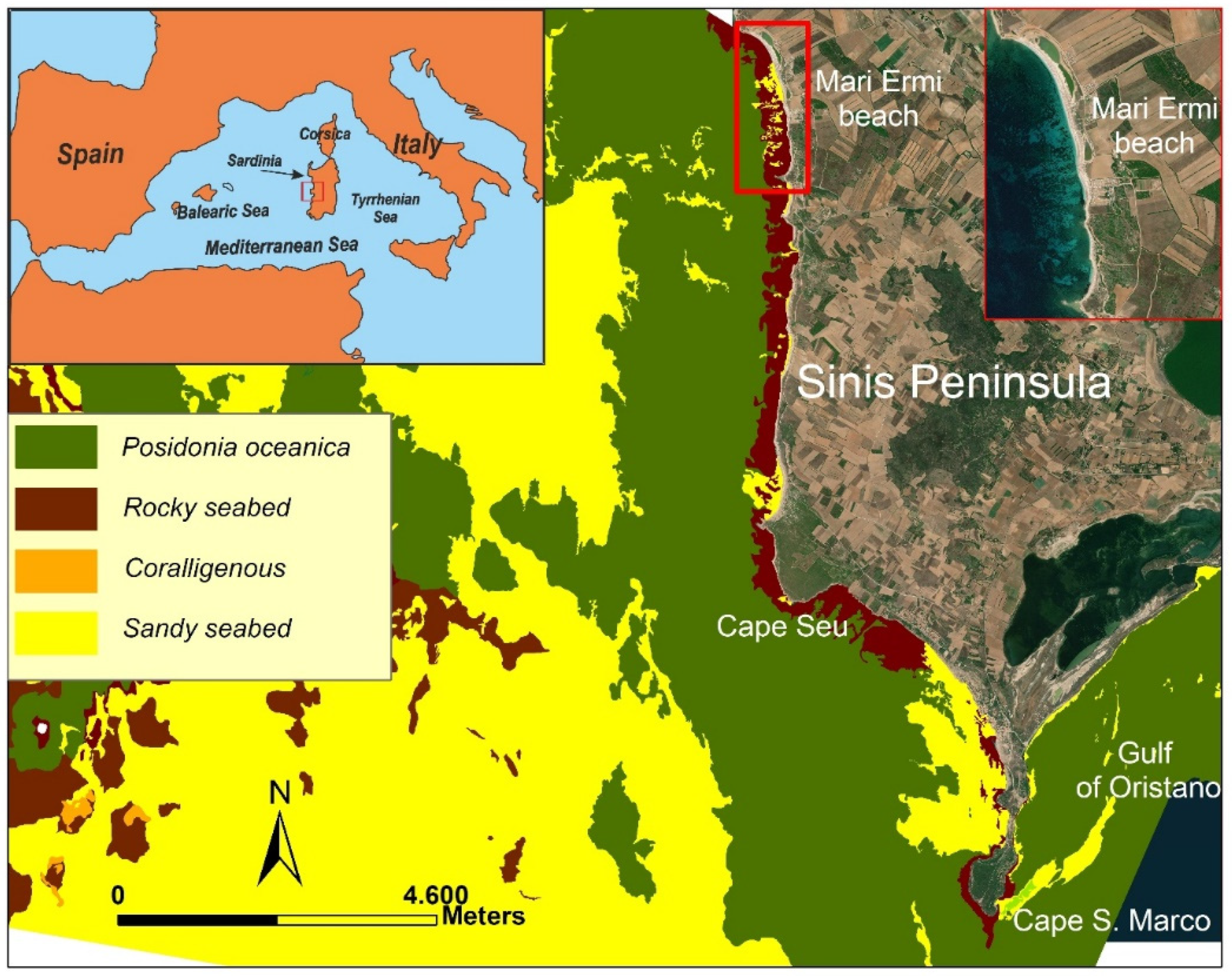
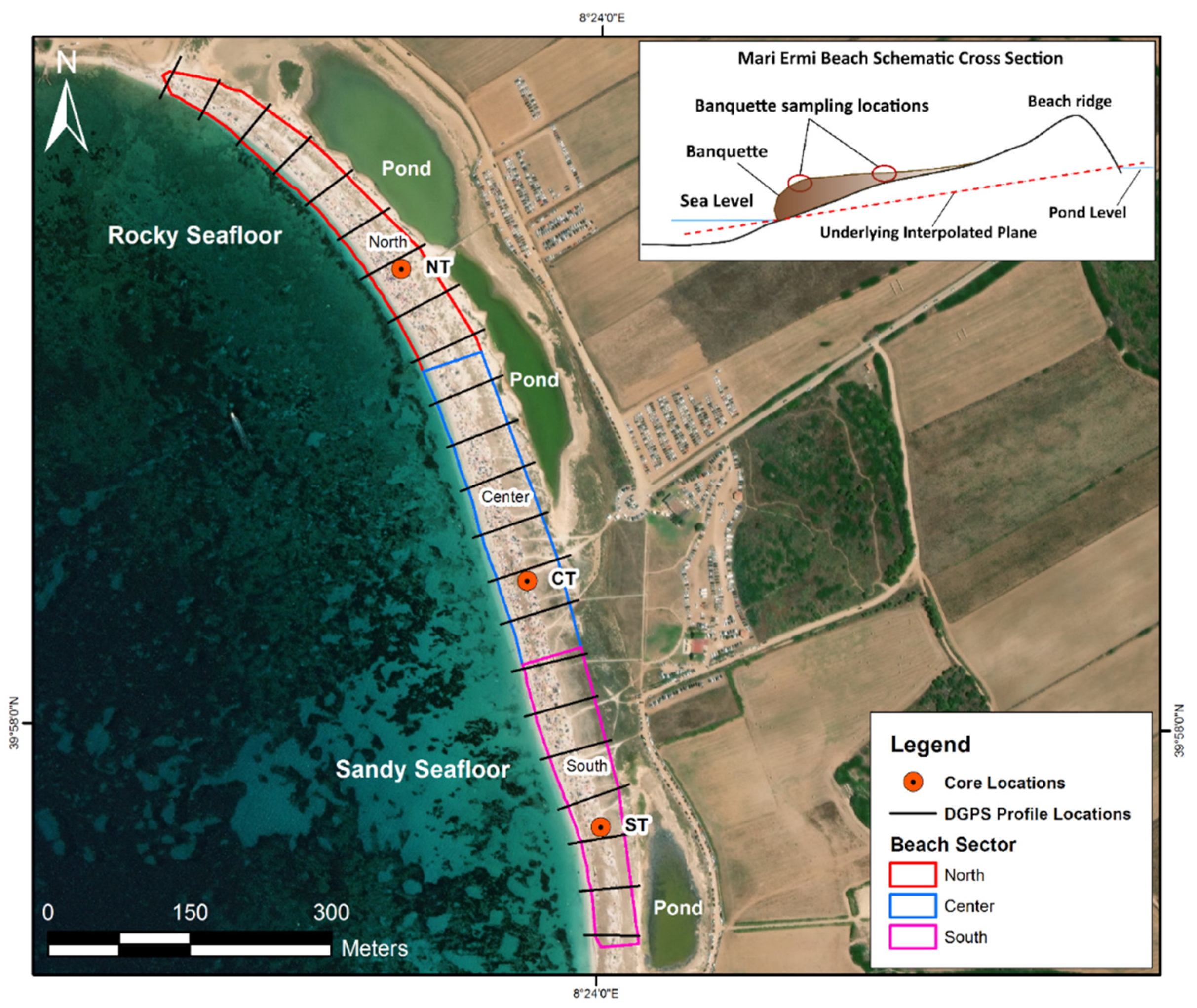
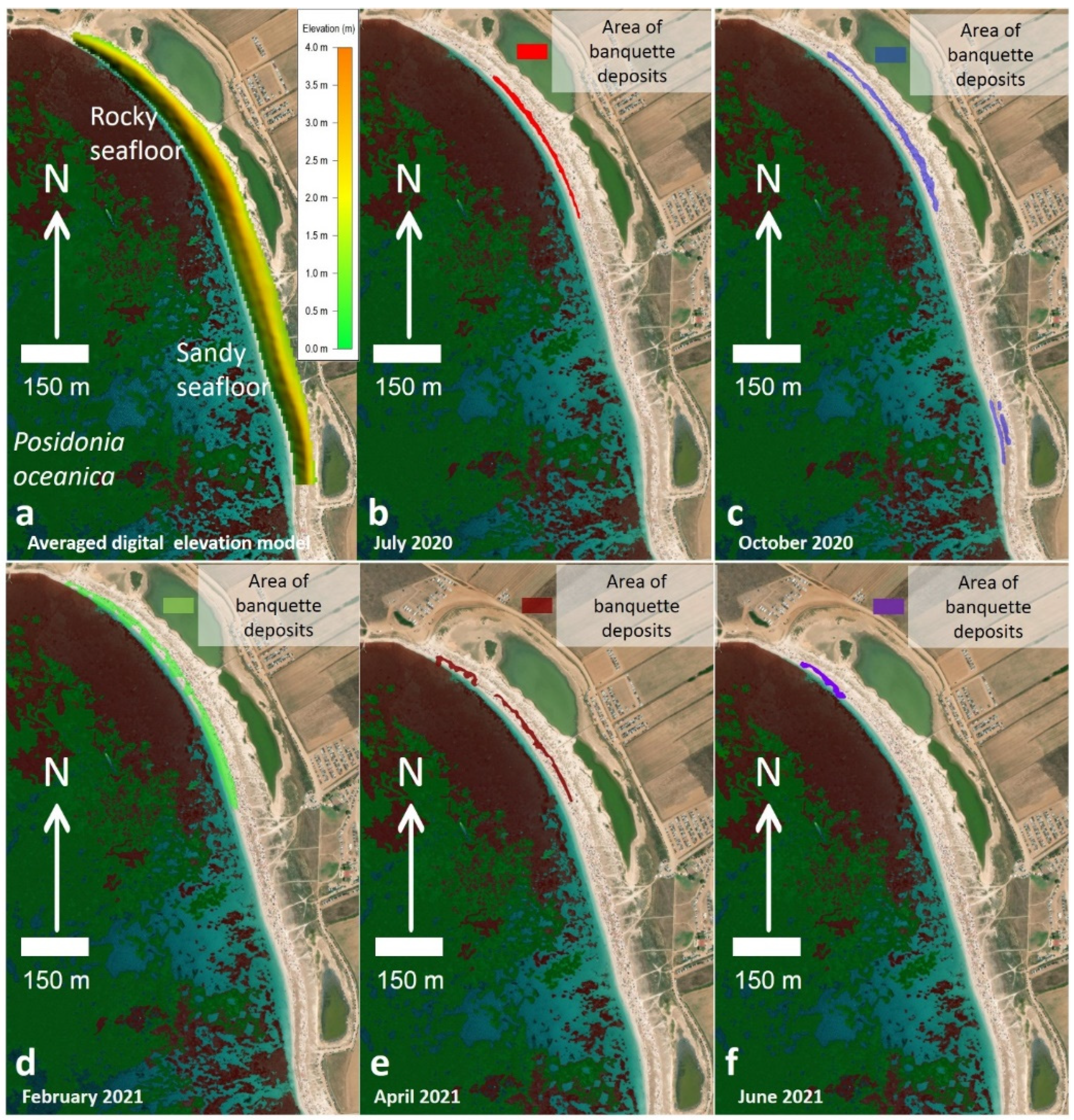
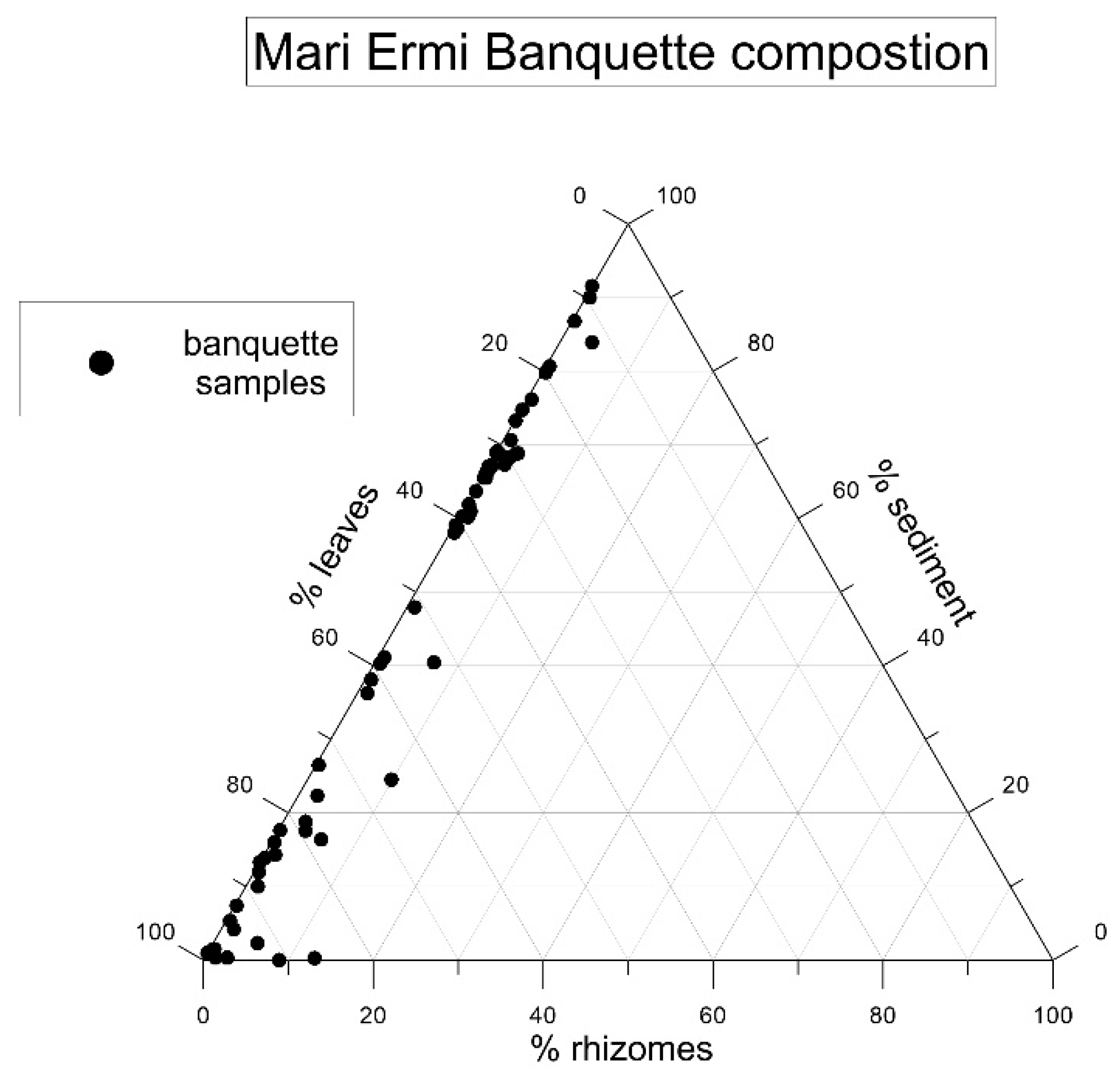
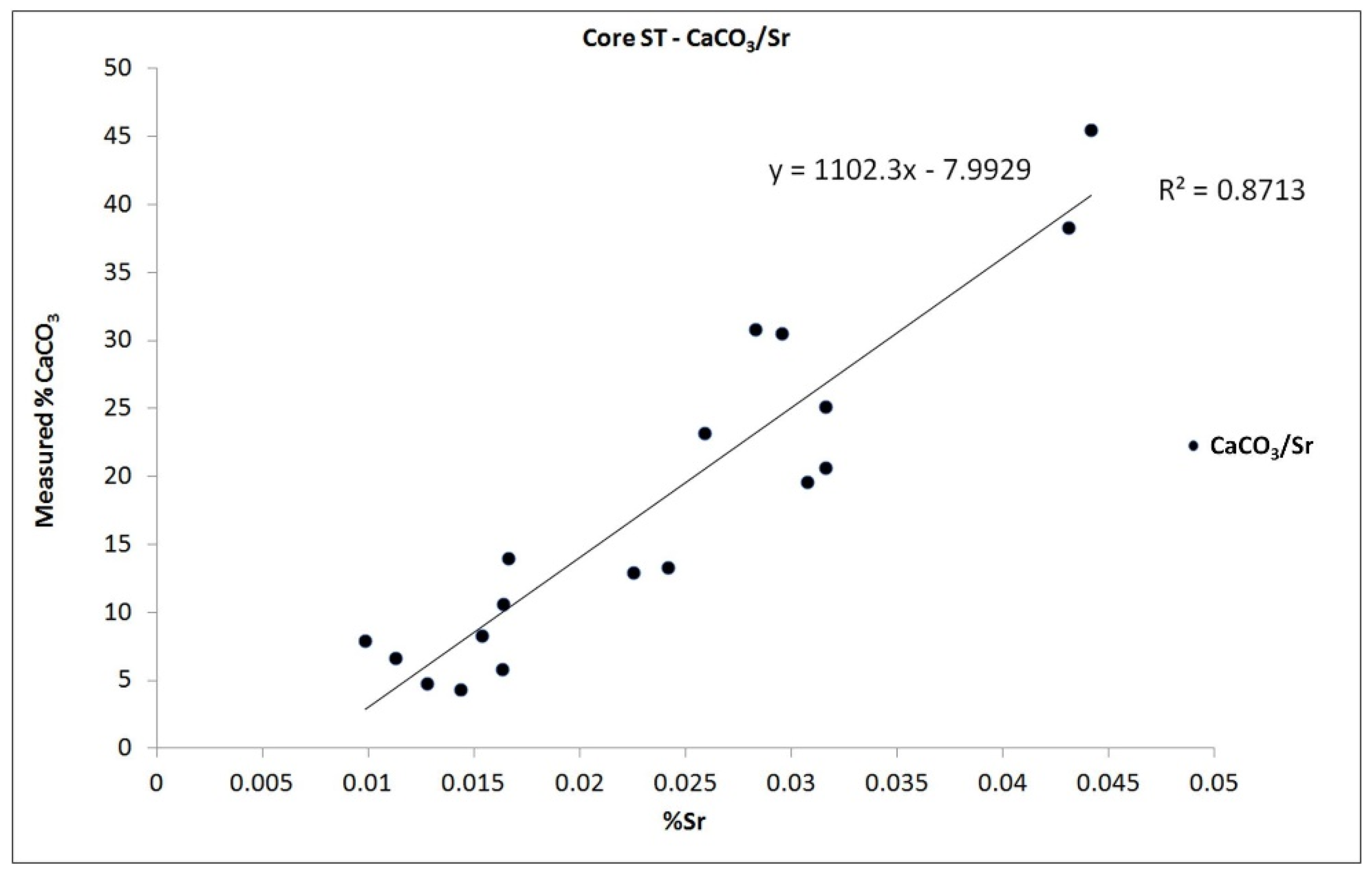

| Survey Period (Number of Samples) | Max ÷ Avg. Sedim. Content (Kg M−3) | Volume of Banquette (M3) | Max Sedim. Mass (103 Kg) |
|---|---|---|---|
| July ′20 (n = 10) | 137 ÷ 105 | 250 | 34 |
| October ′20 (n = 16) | 339 ÷ 126 | 694 | 236 |
| February ′21 (n = 20) | 184 ÷ 35 | 990 | 182 |
| April ′21 (n = 16) | 163 ÷ 62 | 273 | 45 |
| June ′21 | No samples | 114 | No samples |
| Total (n = 62) | 2321 | 497 |
| Parameters for Sediment Mass Calculation | Unit | North | Center | South | Total |
|---|---|---|---|---|---|
| Volume of beach ridge system | m3 | 27,448 | 27,304 | 13,303 | 68,055 |
| Porosity of sands | adim | 0.3 | 0.3 | 0.3 | |
| Calcite density | 103 Kg m00AF3 | 2.71 | 2.71 | 2.71 | |
| Quartz density | 103 Kg m−3 | 2.65 | 2.65 | 2.65 | |
| Carbonate content of beach ridge sediments | % | 3 | 23 | 17 | |
| Dry density of beach sediments | 103 Kg m−3 | 1.86 | 1.86 | 1.86 | |
| Mass of carbonate (biogenic sediments) | 103 Kg | 1533 | 11,689 | 4209 | 17,431 |
| Mass of siliciclastic relict sediments | 103 Kg | 49,556 | 39,132 | 20,552 | 109,240 |
| Total mass of sediments | 103 Kg | 126,671 |
| Posidonia oceanica Banquette Removal and Impact on Sediment Budget | ||||
|---|---|---|---|---|
| Average sediment content | 78 kg m−3 | 100 m3 of banquette removed | 2000 m3 of banquette removed | 5000 m3 of banquette removed |
| Impact on sediment budget (103 Kg) | 7.8 | 156 | 390 | |
| Impact on sediment budget (%) | <0.1% | 0.12% | 0.31% | |
| Maximum sediment content | 339 kg m−3 | |||
| Impact on sediment budget (103 Kg) | 33.9 | 678 | 1695 | |
| Impact on sediment budget (%) | <0.1% | 0.54% | 1.34% | |
Publisher’s Note: MDPI stays neutral with regard to jurisdictional claims in published maps and institutional affiliations. |
© 2022 by the authors. Licensee MDPI, Basel, Switzerland. This article is an open access article distributed under the terms and conditions of the Creative Commons Attribution (CC BY) license (https://creativecommons.org/licenses/by/4.0/).
Share and Cite
Simeone, S.; Palombo, A.G.L.; Antognarelli, F.; Brambilla, W.; Conforti, A.; De Falco, G. Sediment Budget Implications from Posidonia oceanica Banquette Removal in a Starved Beach System. Water 2022, 14, 2411. https://doi.org/10.3390/w14152411
Simeone S, Palombo AGL, Antognarelli F, Brambilla W, Conforti A, De Falco G. Sediment Budget Implications from Posidonia oceanica Banquette Removal in a Starved Beach System. Water. 2022; 14(15):2411. https://doi.org/10.3390/w14152411
Chicago/Turabian StyleSimeone, Simone, Antonio Gian Luca Palombo, Fabio Antognarelli, Walter Brambilla, Alessandro Conforti, and Giovanni De Falco. 2022. "Sediment Budget Implications from Posidonia oceanica Banquette Removal in a Starved Beach System" Water 14, no. 15: 2411. https://doi.org/10.3390/w14152411
APA StyleSimeone, S., Palombo, A. G. L., Antognarelli, F., Brambilla, W., Conforti, A., & De Falco, G. (2022). Sediment Budget Implications from Posidonia oceanica Banquette Removal in a Starved Beach System. Water, 14(15), 2411. https://doi.org/10.3390/w14152411







